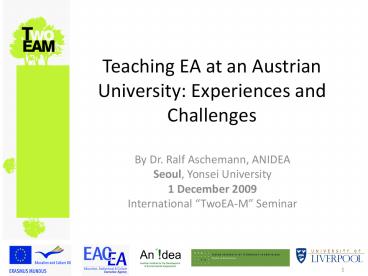Teaching EA at an Austrian University: Experiences and Challenges - PowerPoint PPT Presentation
1 / 20
Title:
Teaching EA at an Austrian University: Experiences and Challenges
Description:
Universities of applied sciences ('Fachhochschulen'): 19. Federal Ministry of Science and Research (FMSR); autonomy since University Act 2002 ... – PowerPoint PPT presentation
Number of Views:31
Avg rating:3.0/5.0
Title: Teaching EA at an Austrian University: Experiences and Challenges
1
Teaching EA at an Austrian University
Experiences and Challenges
- By Dr. Ralf Aschemann, ANIDEA
- Seoul, Yonsei University
- 1 December 2009
- International TwoEA-M Seminar
2
Structure
- Universities in Austria
- Subject Environmental assessment
- Teaching experiences
- Teaching challenges
- Some final remarks
3
Universities in Austria
- Public universities 22
- Private universities 12
- Universities of applied sciences
(Fachhochschulen) 19 - Federal Ministry of Science and Research (FMSR)
autonomy since University Act 2002 - Rector, Academic Senate and University Council
4
Source BMWF(FMSR)
5
Source BMWF(FMSR)
6
Total number of students in Austria
240,000 students at universities 35,000
students at universities of applied
sciences) 5,000 students at private
universities 280,000 students total (8,355,500
population ? 3.4 )
7
Subject Environmental Assessment (EA)
- No M.Sc. or B.Sc. programme in EA in Austria, yet
- But Different courses/lectures in EA (e.g. Graz
University, Graz University of Technology, Vienna
University, Vienna University of Technology,
Klagenfurt University, Innsbruck University etc.)
8
Subject Environmental Assessment (EA) - 2
- Courses/lectures in EA related fields, such as
assessment tech-niques, indicators, GIS,
environ-mental legislation, environmental
economics, environmental plan-ning, management
etc. - I am lecturer at Graz University ? focus
9
Graz University
- Founded 1585
- Six Nobel Prize Awards (e.g. 1933 Erwin
Schrödinger for physics) - Six faculties 74 institutes 22,000 students
2,800 graduates/year 100 degree programmes
staff 3,500 (2,500 scientific) 170 mio
budget/year plus third-party funds (approx. 293
bio Won, 22.5 bio Yen) Source
www.uni-graz.at
10
Graz University - 2
Source www.uni-graz.at
11
Teaching experiences
- EA framework in Austria
- Austrian EIA Act (implementation of EC EIA
Directive) - Austrian SEA legislation (implemen-tation of the
EC SEA Directive) - Federal country (legislation at federal and
provincial level) - Long (environmental/land-use) planning tradition
with many experiences/know how gathered
12
Teaching experiences - 2
- B.Sc. and M.Sc. Programme Environmental system
sciences with lectures in, inter alia, EA and
environmental management - Motivation and interest of students in EA are
varying, but that is not specific to EA - Use of WebCT (e-learning plat-form) turned out to
be positive
13
Teaching experiences - 3
- Legislation issues (Requirements of EC Directives
or annexes of Austrian EIA Act) sometimes
difficult to understand for students - Invitation of guest speakers (e.g. environmental
ombudsman of Styria, EA practitioner) offered
valuable input from the non-academic world
14
Teaching experiences - 4
- Case studies as suitable means for explaining and
demonstrating EA in practice ? EIA Database of
Environment Agency Austria including EIS and
other documents - Visualisation (e.g. process, assess-ment matrix)
eases understanding of complex issues
15
Teaching experiences - 5
Dont behave like an super expert, who does
know anything in the EA context
http//glareanverlag.files.wordpress.com/2007/12/c
artoon009.jpg
16
Teaching challenges
Learning not as burden, but as education for the
(professional and private) future of the students
http//campusib.fh-burgenland.at/images/2240007.1
17
Teaching challenges - 2
- Try to make legislation issues more attractive
and better to understand - Diversity instead of uniformity Guest speakers,
e-learning, case studies, role plays etc. - Overcome students resistance to journal papers
(perhaps only an Austrian phenomenon)
18
Teaching challenges - 3
- Updating lectures in order to offer
state-of-the-art knowledge - Clarifying the relations to the professional
world (e.g. application of EIA Act for different
professions) - Encouraging students to be curious to know more
and detailed EA issues (? e.g. master thesis)
19
Some final remarks
- Experiences and challenges in teaching EA not
unique - EA is important and will become more important in
the future - Bologna process (with its three main objectives
mobility, international competitiveness,
employability) requires efforts for scholars and
students
20
Thank you
... for your kind attention!































